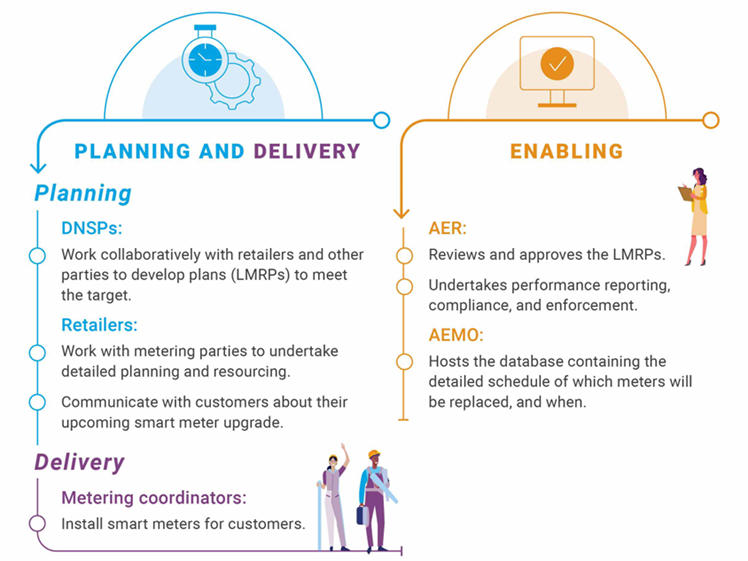Get smart – AEMC draft determination of the smart meter accelerated rollout
Last week, the AEMC published its Accelerating smart meter deployment draft rule, which seeks to deploy smart meters quickly and efficiently, achieving universal uptake by 2030. This fast-tracked rule change follows the AEMC’s extensive metering review, which begun in 2020 and wrapped up final recommendations in 2023.
Accelerating the deployment of smart meters
Smart meters are critical infrastructure to provide a digital foundation for a modern electricity grid and play a vital part in facilitating the efficient integration of Consumer Energy Resources (CER), including solar photovoltaic (PV) systems, home batteries and electric vehicles (EVs). We can’t run a 21st century grid with 19th century meter technology.
Smart meters also provide customers with access to usage data, providing a greater understanding of customers’ own usage and availability of alternative pricing options.
The draft rule recognises the vast benefits for customers and energy stakeholders where smart meters are widespread. The reform seeks to jump start the deployment of smart meters and overcome the restraints of the current metering replacement framework.
Legacy meter replacement plans
To meet the 2030 target, the draft rule establishes a new Legacy Meter Replacement Plan (LMRP) mechanism where distribution network service providers (DNSPs) will work with retailers, metering coordinators (MC) and other stakeholders to develop a plan to replace legacy meters.
The LMRPs will give retailers and metering parties certainty of where and when smart meters would need to be deployed over the 2025-30 acceleration period, enabling them to then plan their resourcing requirements. Importantly, retailers and metering parties will have the option to replace meters ahead of the LMRP meter replacement schedules.
In developing its LMRP, a DNSP will need to consider the following four proposed principles:
- Approximately 15-25 per cent of legacy meters should be planned to be replaced each year
- The overall efficiency of the LMRP, including costs and potential savings, should be taken into account – for example, consideration should be given to grouping installs to promote efficiency
- The impact of the LMRP on retailers and other affected stakeholders should be considered through consultation
- The impact of the LMRP on workforce planning, especially in regional areas, should also be considered – for example, consideration should be given to how parties will use their local workforce to avoid moving installers every year or creating a local boom-bust cycle.
The Australian Energy Regulator (AER) will play a light-touch oversight role ensuring that the LMRPs developed by the DNSPs meet the requirements outlined in the proposed rules, including the prescribed principles. Following approval, the AER will publish the LMRPs on its website.
Under the proposed transitional rule:
- DNSPs will consult with retailers, MCs, and other relevant stakeholders prior to submitting to the AER for approval by 31 January 2025, and
- the AER is required to approve by 31 March 2025 to allow the acceleration program to commence from 1 July 2025.
Under the draft rule, retailers would then be responsible for implementing the LMRPs by arranging for meters to be upgraded in line with the published schedules. Retailers are subject to annual performance reporting requirements on progress, with an allowance made for reopeners if there is a material change in circumstances.
The figure below provides an overview of the different proposed stakeholder roles in the LMRP process.
Figure 1: Proposed stakeholder roles in the LMRP process

Source: AEMC, Accelerating Smart Meter Deployment, Draft rule determination, 4 April 2024
Enabling access to power quality data
Access to power quality data will ensure that DNSPs can better manage and plan their existing network, reducing costs for all customers over the long term. In addition to the network planning benefits, this data can also unlock customer safety benefits by, for example, enabling the timely detection and resolution of neutral integrity faults and voltage excursions at customer premises.
The draft rule is proposing to introduce new arrangements to provide DNSPs with access to this ‘basic’ power quality data free of charge, on an ongoing basis, to unlock the benefits above. Changes to the current framework will ultimately reduce overall costs to consumers by ensuring that DNSPs are no longer simply ‘price-takers’.
Customer experience and protections
Vital to the rollout is the assurance of adequate customer provisions to protect vulnerable customers and ensure a positive customer experience in metering installations. Social licence is considered a significant risk to the success of the accelerated rollout, emphasising the importance of adequate customer awareness and protections.
The AEMC’s draft rule proposes introducing customer safeguards to prohibit retailers from imposing any upfront charges for new smart meters or exit fees during the accelerated rollout period. The draft rule also includes provisions for the amount of information provided to customers including notices around the rollout and notices ahead of any changes to retail pricing structures.
An acceleration to the smart meter rollout is vital to the clean energy transition and modernisation of the electricity grid. Ensuring access to power quality data and prioritising customer protections will maximise the benefits and success of the accelerated rollout. The AEMC is expected to publish its final rule determination by 11 July 2024, with the proposed rules commencing progressively, beginning 25 July 2024.

